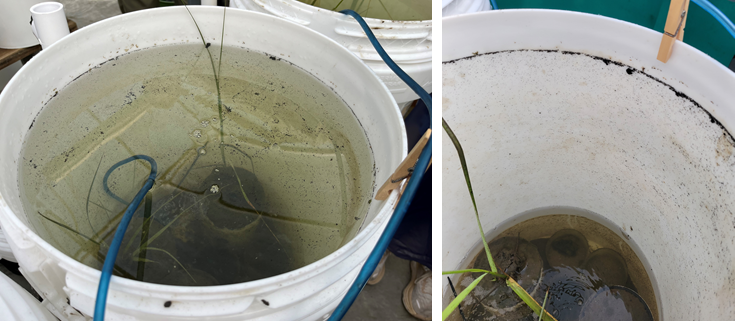The purpose of this project is to examine how microplastic pollution interacts with chemical contamination in coastal ecosystems. We plan to perform a series of laboratory and mesocosm experiments where we expose estuarine organisms to chemical contaminants (such as crude oil and PFAS) in the presence of microplastic particles. We hope to gain an understanding of how microplastics can change or alter the fate and effects of chemical contaminants.
Why We Care
Microplastics, chemicals of emerging concern, and oil continue to be detected and impair coastal ecosystems. These stressors can endanger the health of coastal and estuarine species and can impact human health through consumption of contaminated fish, shellfish, and water.
What We Are Doing
We are exploring the efficacy of using Small Intertidal Microcosm PLant Exposure (SIMPLE) Systems to investigate how microplastics move and distribute within the ecosystem and what effects microplastics and other contaminants of environmental concern have on plants and animals. SIMPLE Systems, which were developed by NCCOS scientists and a student at NOAA’s Hollings Marine Laboratory, are a series of 12-gallon buckets each with a tidal pump and timer to mimic a more simplified version of the intertidal coastal environment and perform studies in a controlled setting.
We assigned 24 SIMPLE systems at random to one of six treatments — four replications for each treatment — for a 21-day exposure. Our team set up each system with seawater, estuarine sediment, cordgrass plantings, juvenile clams, and juvenile grass shrimp. We conducted the experiment in a greenhouse, which receives natural light and temperature cycles with simulated tidal flux. In addition to a control, the individual treatments consisted of microcosms dosed with tire wear particles (small tire particles created from tire friction against the road that end up in the environment), 6-PPD-quinone (the chemical present in tire wear particles) perfluorooctane sulfonic acid (PFOS), microplastic beads, and a combination treatment of PFOS absorbed to microplastic beads. For this experiment, we used crumb rubber from previously used tires with a particle size range of 63 to 150 micrometers, and fluorescent green polyethylene spheres (27–32 um in diameter).

What We Found
Preliminary results indicate that PFOS that was present in seawater was transported into sediments during the 21=day exposure. We detected 6-PPD-quinone in seawater, indicating leaching from the tire wear particles in that treatment. This research is currently ongoing and more results will become available in the near future as sample analysis continues.
Benefits of Our Work
The experiment described above is a pilot to help us direct our future research. As results become available we hope to glean an understanding of potential fate and effect pathways that warrant specific investigation through targeted laboratory studies or more focused mesocosm studies.
Next Steps
The next steps in the study will be centered around a series of laboratory studies and a mesocosm study to examine how clams and other organisms are affected by the interaction between microplastics and oil slicks.
